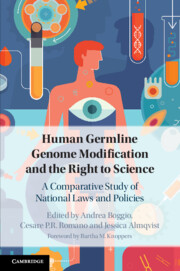 Human Germline Genome Modification and the Right to Science
Human Germline Genome Modification and the Right to Science from Part II - Europe
Published online by Cambridge University Press: 15 November 2019
Belgium regulates research on human embryos, including germline modification, mainly through the 2003 Law regarding Research on Embryos In Vitro and the 2007 Law regarding Medically Assisted Reproduction and the Disposition of Embryos and Gametes. It allows the creation of embryos for research when the research goal cannot be reached by research on supernumerary embryos. The lawmaker only recognizes a gradual difference between embryos created for reproduction and later used for research and embryos specifically created for research purposes. The general rule in research is that no research can be performed for eugenic goals, i.e., selection or improvement of non-pathological characteristics of the human species. Everything that is not prohibited by the law is allowed. The conclusion, supported by the parliamentary debate, is that germline genome editing is permitted for corrective purposes (meaning elimination or correction of genetic diseases), if approval of the local ethics committee and the Federal Commission on scientific research on embryos in vitro is obtained.
To save this book to your Kindle, first ensure [email protected] is added to your Approved Personal Document E-mail List under your Personal Document Settings on the Manage Your Content and Devices page of your Amazon account. Then enter the ‘name’ part of your Kindle email address below. Find out more about saving to your Kindle.
Note you can select to save to either the @free.kindle.com or @kindle.com variations. ‘@free.kindle.com’ emails are free but can only be saved to your device when it is connected to wi-fi. ‘@kindle.com’ emails can be delivered even when you are not connected to wi-fi, but note that service fees apply.
Find out more about the Kindle Personal Document Service.
To save content items to your account, please confirm that you agree to abide by our usage policies. If this is the first time you use this feature, you will be asked to authorise Cambridge Core to connect with your account. Find out more about saving content to Dropbox.
To save content items to your account, please confirm that you agree to abide by our usage policies. If this is the first time you use this feature, you will be asked to authorise Cambridge Core to connect with your account. Find out more about saving content to Google Drive.